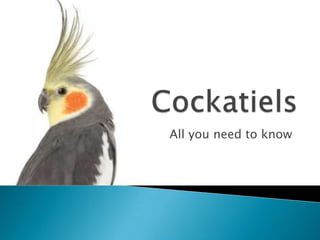
Cockatiels
- 1. All you need to know
- 2. Introduction to Cockatiels Cockatiels as Pets Sexing Cockatiels Dietary Requirements Housing Requirements Breeding of Cockatiels Cockatiel Mutations Health Information
- 3. The Cockatiel (Nymphicus hollandicus), is a parrot native to Australia. They are the second most popular caged bird as a pet in the world They are easily and successfully bred and kept in captivity. They make fantastic pets and can often pick up a few words. They are similar to a cockatoo , just in a much smaller package
- 4. Cockatiels are among the most popular pet birds. Small parrots with a variety of color patterns and a crest, they are attractive as well as friendly and easy to tame. Because of their small size, cockatiel care and taming is easier than some other parrot species. They are capable of mimicking speech, although they can be difficult to understand. However, they are quite good at whistling and can often be taught to whistle tunes.
- 5. Variety is the key to a healthy diet. Seeds can be a nutritious part of the diet, but are high in fat so should only make up a part of the diet (some experts recommend no more than about 30% of the diet). Pelleted diets are often a good choice for birds as they are nutritionally balanced and birds can't pick out their favourite seeds and leave the rest. However, with both seeds and pellets a wide variety of other foods should complement the diet. A variety of fresh vegetables and fruit should be offered, although persistence might be needed before your bird will try new foods (particularly if they are accustomed to an all-seed diet). Proteins such as hard boiled egg, legumes, and cooked meats can be offered in moderation. Sprouted seeds are also an excellent way to add variety to your bird's diet. Avoid avocado.
- 6. Cockatiels are active and playful and should have a large cage. Opinions on the minimum size varies, but a good rule of thumb is at least 20 inches by 20 inches wide, and 26 inches tall as a bare minimum (the more the merrier ) . The spacing on the cage bars should be no more than 3/4 inches (any larger is a safety hazard). Horizontal cage bars offer the best opportunity for climbing and exercise. There should be space to place at least a couple of perches and toys at different levels with enough space to comfortably move between them. Many cockatiel cages come with a removable bottom tray for easy cleaning.
- 7. Cockatiel breeding is not especially difficult, but it will require your time and commitment, in addition to a lot of preparation. Before getting started, there are some things you need to Have/Know: They will breed Nest Box : A true pair You should be in mild or warm Be prepared Vertical or that is old expecting weather , no for Horizontal enough between more than Handrearing, (15-24 ( 2-8 eggs) three clutches a just in case months old) (2-8 chicks !) season should Either have a be allowed brooder or
- 8. For a List of Cockatiel Mutations Click Here
- 9. How can I tell if my pet cockatiel is sick? The biggest sign that your pet cockatiel might be sick is a change in behavior. A healthy pet bird is active and alert: eating, playing and vocalizing. A pet cockatiel that sleeps a lot or sits fluffed up in the corner of the bird cage could be sick. If there is even a slight change from normal cockatiel behavior or if your cockatiel shows other signs of illness, your pet bird could be sick. If your pet cockatiel is sick then take it to an avian veterinarian as soon as possible. In general, cockatiels (and all pet birds, as well as wild parrots) do not show obvious signs of illness. This is a defense mechanism. In the wild, a sick bird or parrot is a target for predators, so all birds (wild birds and pet birds) do everything they can to mask their sickness. Avian Vets in Ireland =>
- 11. It is important to either own a brooder and the equipment nessecery or know someone with them. It is not uncommon for cockatiels to abandon their nests , so be prepared ! , Info on this can be gotten here